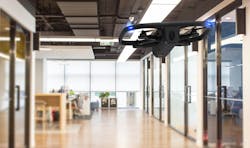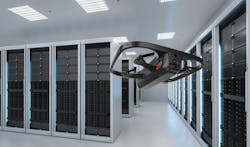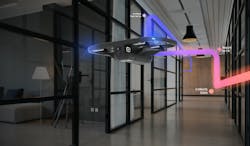This article originally appeared in the March 2024 issue of Security Business magazine. Don’t forget to mention Security Business magazine on LinkedIn and @SecBusinessMag on Twitter if you share it.
In today’s landscape, security and continuous monitoring are both paramount and challenging; however, the limitations of traditional methods are becoming increasingly evident. Stationary sensors, while effective, cannot provide complete coverage. Similarly, relying on human guards for routine inspections is not only costly but also lacks consistency and efficiency.
This gap in surveillance capability poses a critical question: How can we ensure thorough monitoring without compromising on quality or incurring prohibitive costs? The answer lies in the innovative application of autonomous drones – a versatile solution reshaping the landscape of indoor monitoring.
These drones cater to diverse environments, from quiet office spaces needing after-hours surveillance to critical operational areas requiring constant monitoring for thermal anomalies. Their utility extends to large-scale settings like warehouses and malls, where their aerial capabilities provide comprehensive situational awareness.
For security integrators, incorporating drones goes beyond adding a new product to their offerings – it is a strategic enhancement that reduces reliance on human resources, increases safety, and ensures a substantial return on investment for customers.
The Benefits for End-Users
With their advanced AI and robotics technology, autonomous drones are revolutionizing the way indoor surveillance and security can be approached. Incorporating them into indoor security and inspection protocols marks a significant leap forward in safeguarding and managing indoor environments. Here are some of the benefits:
Surveillance: Drones extend beyond the constraints of traditional monitoring systems, offering a dynamic, cost-effective, and comprehensive surveillance solution. Unlike static cameras, drones are not limited to a fixed perspective. They can navigate throughout a facility, offering varied vantage points and covering extensive areas that might be challenging or impossible for humans to reach. This mobility ensures a more thorough and dynamic surveillance process, significantly enhancing security and monitoring capabilities.
Routine patrols: Drones streamline many aspects of security and inspection tasks. By taking over routine patrols and inspections, they free up human resources for more critical tasks that require human judgment and intervention. This transition not only boosts operational efficiency but also enhances safety. Drones can safely navigate and inspect potentially hazardous areas, such as high ceilings, complex machinery, or sensitive materials, reducing the risk to human personnel.
Real-time threat analysis: Equipped with advanced sensors and cameras, drones can capture and relay real-time data back to a control center, which enables immediate analysis and response to any anomalies or security concerns. Whether identifying unauthorized access, detecting potential safety hazards, or monitoring environmental conditions, the immediacy of data provided by drones is invaluable for timely decision-making and action.
Emergency response: In emergency situations, drones can serve as first responders, providing critical real-time information that can potentially prevent or mitigate disaster. They can cover larger areas more swiftly and safely than human guards, ensuring continuous and precise monitoring.
How Autonomous Drone Patrols Work
Autonomous navigation of indoor environments presents a unique set of challenges for robotics systems – markedly different from those encountered outdoors. This distinction is especially relevant in the field of drone technology. Indoor autonomous navigation can be divided into the following key components:
Mission planning – This involves determining the optimal path from one point to another. For effective mission planning, an autonomous drone must have a comprehensive understanding of its environment – akin to having a detailed mental map that includes knowledge of the destination, the pathways to reach it, and contingency plans for unexpected scenarios.
Obstacle detection and avoidance – Also known as ‘sense and avoid,’ this component is crucial for navigating through unpredictable and potentially cluttered spaces. While drones have the advantage of flying above many obstacles, they must still be equipped with sophisticated sensors to detect and navigate around unforeseen barriers. This capability is essential for maintaining a smooth and uninterrupted mission, particularly in complex indoor settings. Through advanced sensor technology, these drones can detect obstacles in their path and dynamically compute alternative routes, or, if necessary, abort the mission to ensure safety.
Pose estimation – This refers to the drone’s ability to ascertain its precise location within a space. Unlike outdoor drones, which rely heavily on GPS for location tracking, indoor drones must use alternative methods, as GPS signals are typically unavailable or highly unreliable indoors due to obstructions like walls, ceilings, and other structural elements inside buildings. Accurate pose estimation is vital, as even minor navigational errors can lead to collisions in the confined spaces of indoor environments.
While outdoor drones can afford some minor deviations of several feet a meter or two without consequence, such discrepancies are unacceptable indoors. In the confined spaces of indoor environments, a slight miscalculation can lead to collisions with objects, walls, or even people. The stakes are higher, and precision is paramount.
To address the complexities of indoor navigation, a synergy of innovative methods and technologies has been developed. Indoor Wi-Fi signals, beacons, and dedicated visual tags are some examples of external signals a robot can map and use to localize itself. Other technologies like LiDAR, radar, and visual odometry enable autonomous machines to sense the environment and to try to estimate their location.
The problem with most methods is that they fail at some point. Cameras miss glass walls or mirrors, LiDAR has a hard time with IR absorbent materials, etc. This necessitates a “Swiss Cheese Model” – based on the principle of layering multiple defenses, much like slices of Swiss cheese with their holes in different places, ensuring that any single issue is mitigated by another layer. With machine learning algorithms, the independence of these layers fortifies the system, ensuring that if one encounters an issue, the others compensate, thus eliminating any single point of failure.
Through such advanced technologies and strategic methodologies, the challenge of indoor navigation is being progressively addressed, paving the way for safe and efficient indoor drone operation in various settings.
Target Verticals
The integration of drones into security infrastructures is becoming increasingly compelling, and the first step is a thorough assessment of the specific needs and environment. Understanding the unique challenges and requirements of each environment ensures that the chosen drone system maximizes effectiveness and ROI – whether it is a model designed for smaller spaces like offices and operational areas or one for larger areas like warehouses and malls.
Office spaces and commercial buildings: These environments require a delicate balance between effective surveillance and privacy. After-hours, when the premises are empty, drones can provide comprehensive surveillance without any privacy concerns. They can navigate autonomously, and their ability to detect intrusions, coupled with AI capabilities for identifying unusual activities, makes them a sophisticated alternative to traditional video surveillance and security personnel.
Operational areas: Remote data centers, hazardous labs, electrical substations, and similar indoor facilities require vigilant monitoring due to their critical nature. Drones excel in these settings thanks to advanced thermal detection capabilities, providing a crucial layer of safety.
In instances where an alarm is triggered, the traditional response of dispatching personnel can be time-consuming and risky, particularly if the alert indicates a potential hazard like a gas leak or electrical issue. Here, indoor drones offer a safer and more efficient solution. They can swiftly navigate to the alarm’s location, autonomously assess the situation, and determine if it is a false alarm or a real threat requiring specialized intervention.
This rapid drone deployment for initial assessment is particularly beneficial in isolated or rural operational areas. For example, if there is a suspected intrusion at a remote data center, the drone can quickly confirm the breach, or if a thermal anomaly is detected in a lab, the drone can safely evaluate the potential overheating of equipment. This immediate reconnaissance helps decide the necessary response, whether it involves security, maintenance teams, or emergency services.
Warehouses and fulfillment centers: The vast spaces and high ceilings of warehouses make them ideal candidates for drone surveillance. Drones designed for such environments can provide safety oversight and complete situational awareness. They can perform high-altitude inspections and monitor shelving integrity, fire safety systems, and emergency evacuation readiness – ensuring a safer and more secure environment for warehouse operations.
Shopping malls: In retail settings, particularly in large malls, drones offer an efficient way to maintain security and operational efficiency. Their ability to provide a complete view of the environment, coupled with AI-driven analysis, helps in identifying potential security breaches, monitoring customer traffic patterns, and ensuring overall safety. Drones can navigate these dynamic spaces effectively, providing real-time insights that are crucial for both security and customer experience management.
The Role of the Security Integrator
For security integrators, as well as remote monitoring and guarding companies, the adoption of autonomous drone patrols offers several compelling advantages. Primarily, it significantly reduces dependence on human manpower – particularly beneficial given the current challenges of labor shortages and high staff turnover rates.
Moreover, contrary to the typical concerns about the high initial costs of advanced technology, drones can be an affordable investment. This affordability, combined with the significant long-term savings in labor costs and the drones’ operational efficiency, enhances the value proposition. The high ROI of these drones makes them an economically attractive solution for indoor monitoring and inspection, making this cutting-edge security technology accessible to a wide range of customers.
Amit Moran is co-founder and COO of Indoor Robotics, a Israel-based provider of autonomous drone systems for safety and security applications. Mr. Moran has been recognized with the 2023 Security Industry Association’s (SIA) Innovation Award for his notable contributions to the security industry, and he is the co-founder of the Israeli Robotics community. www.indoor-robotics.com
About the Author

Amit Moran
Amit Moran is co-founder and COO of Indoor Robotics, a Israel-based provider of autonomous drone systems for safety and security applications. Mr. Moran has been recognized with the 2023 Security Industry Association’s (SIA) Innovation Award for his notable contributions to the security industry, and he is the co-founder of the Israeli Robotics community. www.indoor-robotics.com


